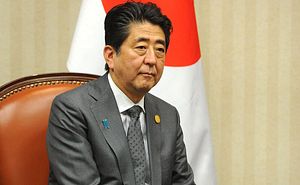On Sunday, the candidate backed by the ruling Liberal Democratic Party (LDP) and their junior coalition party, the Komeito, won Sunday’s gubernatorial election in Ibaraki Prefecture. Kazuhiko Oigawa’s win in the first major local election since the Cabinet shakeup is a good sign for Prime Minister Shinzo Abe and the LDP.
Given the significance of this race’s optics, LDP made a concerted effort to deny incumbent Masaru Hashimoto a seventh four-year term. If Hashimoto had won, he would have become the longest serving among Japan’s incumbent governors.
The local chapter of the Japanese Trade Union Confederation backed Hashimoto, and he campaigned on public opposition to restarting the Tokai No. 2 nuclear power plant. According to a Kyodo News poll last week, 65 percent of voters in Ibaraki opposed restarting Tokai No. 2, which will legally be required to begin decommissioning if it cannot clear tougher safety screening required for restarts by November 2018. About 960,000 people live within 30km of the reactor “making it the biggest reactor-centric population in the country,” according to the Japan Times.
Oigawa did not take a clear stance on the nuclear power plant issue. Instead, he targeted Hashimoto’s long tenure, running on a platform that promised term limits for governors.
Interestingly, voter turnout jumped from 43.48 percent to 31.74 percent in the previous election. More Japanese may be interested in politics, even at the local level, given the political turmoil at the national level.
Though a loss by the LDP-backed candidate would have likely been blown out of proportion, it is an open question whether this victory – 47 percent of Ibaraki voters went for Oigawa, while 41 percent for Hashimoto and 12 percent for a Japan Communist Party-backed third candidate – will have a lasting stabilizing effect.
Just how tumultuous have things been? Originally, the Japanese government had intended to announce the dates of Emperor Akihito’s abdication and the start of the new era in September, but the decision is likely to be postponed.
The next big date on Japan’s electoral calendar is October 22, when there will be by-elections for three seats in the House of Representatives. The LDP is all in to shore up their position.
But the overall trend is looking up for the LDP. The Cabinet’s approval rating had sunk to 39 percent in late July, but increased to 42 percent in the first survey conducted after the early August Cabinet reshuffle, and increased further to 46 percent in the latest survey, according to the Nikkei Asian Review.
Another development to watch? How Abe’s response to North Korea’s continued provocations plays out in voters’ evaluation of his capability as a leader. On Tuesday, he told reporters in brief remarks before an emergency meeting, “We will make utmost efforts to firmly protect the lives of the people.” With TV announcements and push notifications, the government has heightened the awareness of the Japanese public to the North Korean threat. But whether, politically speaking, the gambit will pay off depends on how competently Abe is seen as reacting to the missile firing.
According to a recent NAR survey, 44 percent of respondents favor stronger sanctions, 36 percent favor pursuing resolution through dialogue, and 14 percent favor military action.

































